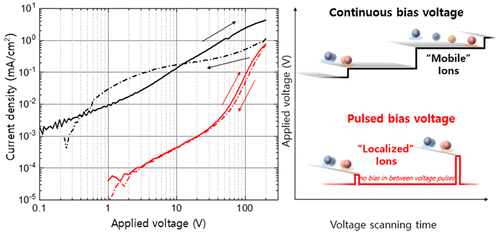当前位置:
X-MOL 学术
›
ACS Energy Lett.
›
论文详情
Our official English website, www.x-mol.net, welcomes your feedback! (Note: you will need to create a separate account there.)
Toward Understanding Space-Charge Limited Current Measurements on Metal Halide Perovskites
ACS Energy Letters ( IF 22.0 ) Pub Date : 2020-01-09 , DOI: 10.1021/acsenergylett.9b02720 Elisabeth A. Duijnstee 1 , James M. Ball 1 , Vincent M. Le Corre 2 , L. Jan Anton Koster 2 , Henry J. Snaith 1 , Jongchul Lim 1
ACS Energy Letters ( IF 22.0 ) Pub Date : 2020-01-09 , DOI: 10.1021/acsenergylett.9b02720 Elisabeth A. Duijnstee 1 , James M. Ball 1 , Vincent M. Le Corre 2 , L. Jan Anton Koster 2 , Henry J. Snaith 1 , Jongchul Lim 1
Affiliation

|
Metal halide perovskite semiconductors have sprung to the forefront of research into optoelectronic devices and materials, largely because of their remarkable photovoltaic efficiency records above 25% in single-junction devices and 28% in tandem solar cells, achieved within a decade of research. Despite this rapid progress, ionic conduction within the semiconductor still puzzles the community and can have a significant impact on all metal halide perovskite-based optoelectronic devices because of its influence upon electronic and optoelectronic processes. This phenomenon thus also makes the interpretation of electrical characterization techniques, which probe the fundamental properties of these materials, delicate and complex. For example, space-charge limited current measurements are widely used to probe defect densities and carrier mobilities in perovskites. However, the influence of mobile ions upon these measurements is significant but has yet to be considered. Here we report the effect of mobile ions upon electronic conductivity during space-charge limited current measurements of MAPbBr3 single crystals and show that conventional interpretations deliver erroneous results. We introduce a pulsed-voltage space-charge limited current procedure to achieve reproducible current–voltage characteristics without hysteresis. From this revised pulsed current–voltage sweep, we elucidate a lower bound trap-density value of 2.8 ± 1.8 × 1012 cm–3 in MAPbBr3 single crystals. This work will lead to more accurate characterization of halide perovskite semiconductors and ultimately more effective device optimization.
中文翻译:

旨在了解金属卤化物钙钛矿上的电荷限制电流测量
钙钛矿金属卤化物半导体已跃居光电子器件和材料研究的最前沿,这主要是因为在十年的研究中,其单结器件的光伏效率记录超过了25%,串联太阳能电池的光伏效率记录超过了28%。尽管取得了如此迅速的进展,但半导体内的离子传导仍然困扰着整个社区,并且由于其对电子和光电过程的影响,因此可能对所有基于金属卤化物钙钛矿的光电器件产生重大影响。因此,这种现象也使电特性技术的解释成为可能,这些技术探究了这些材料的基本特性,既精致又复杂。例如,空间电荷限制电流测量被广泛用于探测钙钛矿中的缺陷密度和载流子迁移率。但是,移动离子对这些测量的影响很大,但尚未考虑。在这里,我们报告了移动离子对MAPbBr的空间电荷限制电流测量过程中电子电导率的影响3个单晶并显示常规解释会产生错误的结果。我们引入了脉冲电压空间电荷限制电流程序,以实现可重现的电流电压特性而没有滞后现象。通过修改后的脉冲电流-电压扫描,我们可以得出MAPbBr 3单晶的下限陷阱密度值为2.8±1.8×10 12 cm –3。这项工作将导致更准确地表征卤化钙钛矿半导体,并最终实现更有效的器件优化。
更新日期:2020-01-10
中文翻译:

旨在了解金属卤化物钙钛矿上的电荷限制电流测量
钙钛矿金属卤化物半导体已跃居光电子器件和材料研究的最前沿,这主要是因为在十年的研究中,其单结器件的光伏效率记录超过了25%,串联太阳能电池的光伏效率记录超过了28%。尽管取得了如此迅速的进展,但半导体内的离子传导仍然困扰着整个社区,并且由于其对电子和光电过程的影响,因此可能对所有基于金属卤化物钙钛矿的光电器件产生重大影响。因此,这种现象也使电特性技术的解释成为可能,这些技术探究了这些材料的基本特性,既精致又复杂。例如,空间电荷限制电流测量被广泛用于探测钙钛矿中的缺陷密度和载流子迁移率。但是,移动离子对这些测量的影响很大,但尚未考虑。在这里,我们报告了移动离子对MAPbBr的空间电荷限制电流测量过程中电子电导率的影响3个单晶并显示常规解释会产生错误的结果。我们引入了脉冲电压空间电荷限制电流程序,以实现可重现的电流电压特性而没有滞后现象。通过修改后的脉冲电流-电压扫描,我们可以得出MAPbBr 3单晶的下限陷阱密度值为2.8±1.8×10 12 cm –3。这项工作将导致更准确地表征卤化钙钛矿半导体,并最终实现更有效的器件优化。


























 京公网安备 11010802027423号
京公网安备 11010802027423号